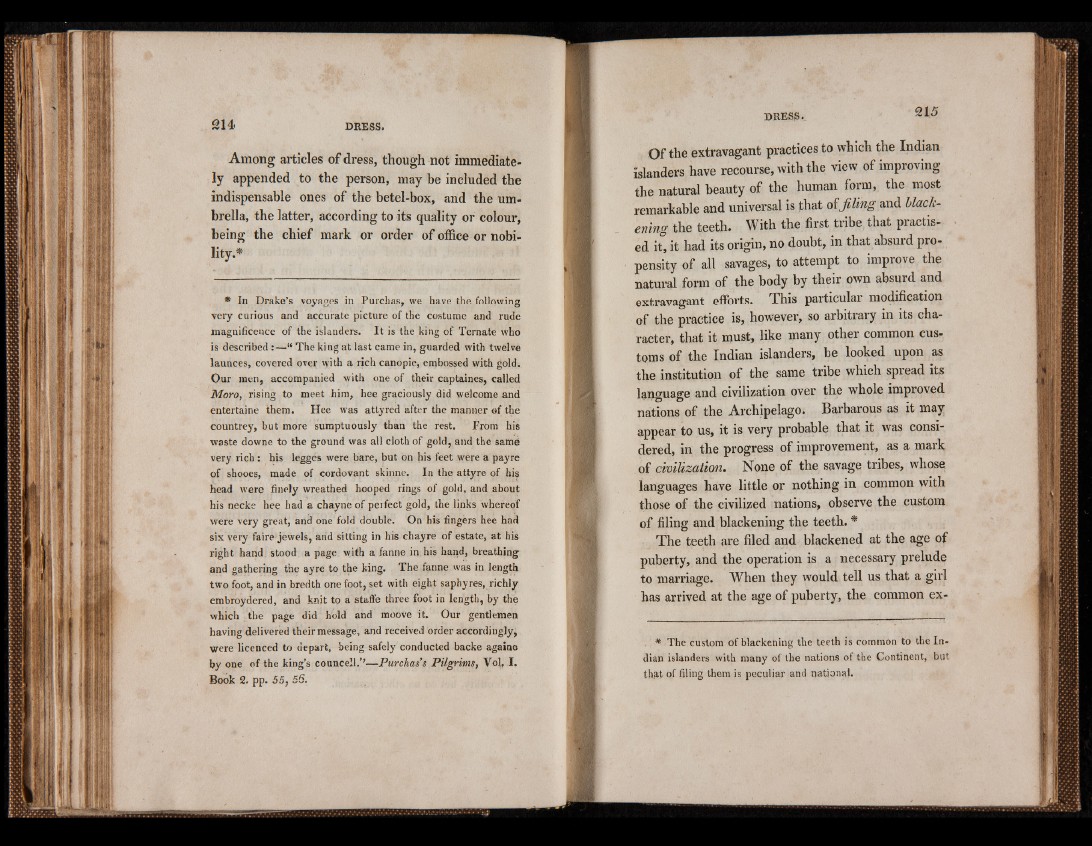
Among articles of dress, though not immediately
appended to the person, may be included the
indispensable ones of the betel-box, and the umbrella,
the latter, according to its quality or colour,
being the chief mark or order of office or nobility.*
* In Drake’s voyages in Purchas, we have the following
very curious and accurate picture of the costume and rude
magnificence of the islanders. I t is the king of Ternate who
is described “ The king at last came in, guarded with twelve
launces, covered over with a rich canopie, embossed with gold.
Our men, accompanied with one of their captaines, called
Moro, rising to meet him, hee graciously did welcome and
entertaine them. Hee was attyred after the manner of the
countrey, but more sumptuously than the rest. From his
waste downe to the ground was all cloth of gold, and the same
very rich: his legges were bare, but on his feet were a payre
of shooes, made of cordovant skinne. In the attyre of his
head were finely wreathed hooped rings of gold, and about
his necke hee had a chayne of perfect gold, the links whereof
were very great, and one fold double. On his fingers hee had
six very faire jewels, and sitting in his chayre of estate, at his
right hand stood a page with a fanne in his hand, breathing
and gathering the ayre to the king. The fanne was in length
two foot, and in bredth one foot, set with eight saphyres, richly
embroydered, and knit tp a staffe three foot in length, by the
which the page did hold and moove it. Our gentlemen
having delivered their message, and received order accordingly,
were licenced to depart, being safely conducted backe againe
by one of the king’s councell.’’—Purchas's Pilgrims, Vol. I.
Book 2. pp. 55, 56.
Of the extravagant practices to which the Indian
islanders have recourse, with the view of improving
the natural beauty of the human form, the most
remarkable and universal is that of filing and blackening
the teeth. With the first tribe that practised
ii, it had its origin, no doubt, in that absurd propensity
of all savages, to attempt to improve the
natural form of the body by their own absurd and
extravagant efforts. This particular modification
of the practice is, however, so arbitrary in its character,
that it must, like many other common customs
of the Indian islanders, be looked upon as
the institution of the same tribe which spread its
language and civilization over the whole improved
nations of the Archipelago. Barbarous as it may
appear to us, it is very probable that it was considered,
in the progress of improvement, as a mark
of civilization. None of the savage tribes, whose
languages have little or nothing in common with
those of the civilized nations, observe the custom
of filing and blackening the teeth. *
The teeth are filed and blackened at the age of
puberty, and the operation is a necessary prelude
to marriage. When they would tell us that a girl
has arrived at the age of puberty, the common ex-
. * The custom of blackening the teeth is common to the Indian
islanders with many of the nations of the Continent, but
that of filing them is peculiar and national.